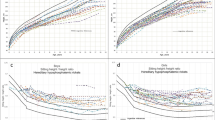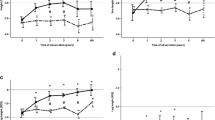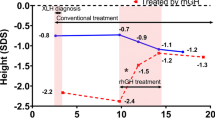Abstract
Children with X-linked hypophosphatemic rickets (XLH) are prone to severe stunting. A multicenter mixed-longitudinal study was conducted to assess age-related stature, sitting height, arm and leg length in XLH patients on continuous treatment with phosphate and calcitriol. Mean standard deviation scores (SDS) for all body dimensions were markedly reduced and differed significantly among each other at the initial and subsequent evaluations (baseline: stature −2.48 SDS; sitting height −0.99 SDS; arm length −1.81 SDS; leg length −2.90 SDS; each p < 0.001). A strong association between stature and leg length (r 2= 0.87, p < 0.001) was noted. Leg length SDS decreased progressively during childhood (2–9 years) and adolescence (12–15 years; each p < 0.001). Sitting height SDS increased significantly during late childhood, indicating uncoupled growth of the legs and trunk and resulting in an ever increasing sitting height index (i.e. ratio of sitting height to stature; age 2 years 2.0 SDS; age 10 years 3.3 SDS; p < 0.001) that was associated with the degree of stunting (r 2 = 0.314, p< 0.001). Mean serum phosphate levels were positively associated with stature and leg length, but negatively with sitting height index. Based on these results, we can conclude that growth of the legs and trunk is uncoupled in XLH and related to serum phosphate levels.





Similar content being viewed by others
Abbreviations
- FGF-23:
-
fibroblast growth factor-23
- PHEX:
-
phosphate regulating endopeptidase homolog X-linked
- PTH:
-
parathyroid hormone
- rhGH:
-
recombinant human growth hormone
- SDS:
-
standard deviation score
- XLH:
-
X-linked hypophosphatemic rickets
References
Bastepe M, Jüppner H (2008) Inherited hypophosphatemic disorders in children and the evolving mechanisms of phosphate regulation. Rev Endocr Metab Disord 9:171–180
The HYP Consortium (1995) A gene (PEX) with homologies to endopeptidases is mutated in patients with X-linked hypophosphatemic rickets. Nat Genet 11:130–136
Ichikawa S, Traxler EA, Estwick SA, Curry LR, Johnson ML, Sorenson AH, Imel EA, Econs MJ (2008) Mutational survey of the PHEX gene in patients with X-linked hypophosphatemic rickets. Bone 43:663–666
Jan de Beur SM, Levine MA (2002) Molecular pathogenesis of hypophosphatemic rickets. J Clin Endocrinol Metab 87:2467–2473
Strom TM, Jüppner H (2008) PHEX, FGF23, DMP1 and beyond. Curr Opin Nephrol Hypertens 17:357–362
Alon US (2006) Hypophosphatemic vitamin-D resistant rickets. In: Favus MJ (ed) Primer on the metabolic bone diseases and disorders of mineral metabolism. American Society of Bone and Mineral Research, Washington D.C., pp 342–345
Reusz GS, Latta K, Hoyer PF, Byrd DJ, Ehrich JH, Brodehl J (1990) Evidence suggesting hyperoxaluria as a cause of nephrocalcinosis in phosphate-treated hypophosphataemic rickets. Lancet 335:1240–1243
Patzer L, van't Hoff W, Shah V, Hallson P, Kasidas GP, Samuell C, de Bruyn R, Barratt TM, Dillon MJ (1999) Urinary supersaturation of calcium oxalate and phosphate in patients with X-linked hypophosphatemic rickets and in healthy schoolchildren. J Pediatr 135:611–617
Kooh SW, Binet A, Daneman A (1994) Nephrocalcinosis in X-linked hypophosphataemic rickets: its relationship to treatment, kidney function, and growth. Clin Invest Med 17:123–130
Schmitt CP, Mehls O (2004) The enigma of hyperparathyroidism in hypophosphatemic rickets. Pediatr Nephrol 19:473–477
Berndt M, Ehrich JH, Lazovic D, Zimmermann J, Hillmann G, Kayser C, Prokop M, Schirg E, Siegert B, Wolff G, Brodehl J (1996) Clinical course of hypophosphatemic rickets in 23 adults. Clin Nephrol 45:33–41
Friedman NE, Lobaugh B, Drezner MK (1993) Effects of calcitriol and phosphorus therapy on the growth of patients with X-linked hypophosphatemia. J Clin Endocrinol Metab 76:839–844
Glorieux FH, Marie PJ, Pettifor JM, Delvin EE (1980) Bone response to phosphate salts, ergocalciferol, and calcitriol in hypophosphatemic vitamin D-resistant rickets. N Engl J Med 303:1023–1031
Haffner D, Weinfurth A, Manz F, Schmidt H, Bremer HJ, Mehls O, Scharer K (1999) Long-term outcome of paediatric patients with hereditary tubular disorders. Nephron 83:250–260
Haffner D, Nissel R, Wuhl E, Mehls O (2004) Effects of growth hormone treatment on body proportions and final height among small children with X-linked hypophosphatemic rickets. Pediatrics 113:e593–e596
Steendijk R, Hauspie RC (1992) The pattern of growth and growth retardation of patients with hypophosphataemic vitamin D-resistant rickets: a longitudinal study. Eur J Pediatr 151:422–427
Verge CF, Lam A, Simpson JM, Cowell CT, Howard NJ, Silink M (1991) Effects of therapy in X-linked hypophosphatemic rickets. N Engl J Med 325:1843–1848
Steendijk R, Herweijer TJ (1984) Height, sitting height and leg length in patients with hypophosphataemic rickets. Acta Paediatr Scand 73:181–184
Ariceta G, Langman CB (2007) Growth in X-linked hypophosphatemic rickets. Eur J Pediatr 166:303–309
Petersen DJ, Boniface AM, Schranck FW, Rupich RC, Whyte MP (1992) X-linked hypophosphatemic rickets: a study (with literature review) of linear growth response to calcitriol and phosphate therapy. J Bone Miner Res 7:583–597
Reusz GS, Hoyer PF, Lucas M, Krohn HP, Ehrich JH, Brodehl J (1990) X linked hypophosphataemia: treatment, height gain, and nephrocalcinosis. Arch Dis Child 65:1125–1128
Seikaly MG, Waber PG, Baum M (2008) Urinary prostaglandins and the effect of indomethacin on phosphate excretion in children with hypophosphatemic rickets. Pediatr Res 64:210–212
Cho HY, Lee BH, Kang JH, Ha IS, Cheong HI, Choi Y (2005) A clinical and molecular genetic study of hypophosphatemic rickets in children. Pediatr Res 58:329–333
Hoyer PF (1996) Nephrokalzinose. In: Hofmann V, Deeg KH, Hoyer PF (eds) Ultraschall-diagnostik in Pädiatrie und Kinderchirurgie. Thieme, Stuttgart, New York, pp 372–374
Weiner JS, Lourie JA (1981) Practical human biology. Academic Press, London
Živičnjak M, Franke D, Filler G, Haffner D, Froede K, Nissel R, Haase S, Offner G, Ehrich JH, Querfeld U (2007) Growth impairment shows an age-dependent pattern in boys with chronic kidney disease. Pediatr Nephrol 22:420–429
Živičnjak M, Narancic NS, Szirovicza L, Franke D, Hrenovic J, Bisof V (2003) Gender-specific growth patterns for stature, sitting height and limbs length in Croatian children and youth (3 to 18 years of age). Coll Antropol 27:321–334
Zivicnjak M, Smolej Narancic N, Szirovicza L, Franke D, Hrenovic J, Bisof V, Tomas Z, Skaric-Juric T (2008) Gender-specific growth patterns of transversal body dimensions in Croatian children and youth (2 to 18 years of age). Coll Antropol 32:419–431
Kruse K, Hinkel GK, Griefahn B (1998) Calcium metabolism and growth during early treatment of children with X-linked hypophosphataemic rickets. Eur J Pediatr 157:894–900
Pedersen HE, Mc CH (1951) Vitamin-resistant rickets. J Bone Joint Surg Am 33:203–220
Imel EA, DiMeglio LA, Hui SL, Carpenter TO, Econs MJ (2010) Treatment of X-linked hypophosphatemia with calcitriol and phosphate increases circulating fibroblast growth factor 23 concentrations. J Clin Endocrinol Metab 95:1846–1850
Wesseling-Perry K, Pereira RC, Wang H, Elashoff RM, Sahney S, Gales B, Juppner H, Salusky IB (2009) Relationship between plasma fibroblast growth factor-23 concentration and bone mineralization in children with renal failure on peritoneal dialysis. J Clin Endocrinol Metab 94:511–517
Rauch F (2009) Overview of rickets in children. UpToDate, Inc. Available at: http://www.uptodate.com
Gaucher C, Walrant-Debray O, Nguyen TM, Esterle L, Garabedian M, Jehan F (2009) PHEX analysis in 118 pedigrees reveals new genetic clues in hypophosphatemic rickets. Hum Genet 125:401–411
Ruchon AF, Tenenhouse HS, Marcinkiewicz M, Siegfried G, Aubin JE, DesGroseillers L, Crine P, Boileau G (2000) Developmental expression and tissue distribution of Phex protein: effect of the Hyp mutation and relationship to bone markers. J Bone Miner Res 15:1440–1450
Ecarot B, Glorieux FH, Desbarats M, Travers R, Labelle L (1995) Effect of 1, 25-dihydroxyvitamin D3 treatment on bone formation by transplanted cells from normal and X-linked hypophosphatemic mice. J Bone Miner Res 10:424–431
Holm IA, Nelson AE, Robinson BG, Mason RS, Marsh DJ, Cowell CT, Carpenter TO (2001) Mutational analysis and genotype-phenotype correlation of the PHEX gene in X-linked hypophosphatemic rickets. J Clin Endocrinol Metab 86:3889–3899
Jehan F, Gaucher C, Nguyen TM, Walrant-Debray O, Lahlou N, Sinding C, Dechaux M, Garabedian M (2008) Vitamin D receptor genotype in hypophosphatemic rickets as a predictor of growth and response to treatment. J Clin Endocrinol Metab 93:4672–4682
Baroncelli GI, Bertelloni S, Ceccarelli C, Saggese G (2001) Effect of growth hormone treatment on final height, phosphate metabolism, and bone mineral density in children with X-linked hypophosphatemic rickets. J Pediatr 138:236–243
Haffner D, Wuhl E, Blum WF, Schaefer F, Mehls O (1995) Disproportionate growth following long-term growth hormone treatment in short children with X-linked hypophosphataemia. Eur J Pediatr 154:610–613
Seikaly MG, Brown R, Baum M (1997) The effect of recombinant human growth hormone in children with X-linked hypophosphatemia. Pediatrics 100:879–884
Alon US, Levy-Olomucki R, Moore WV, Stubbs J, Liu S, Quarles LD (2008) Calcimimetics as an adjuvant treatment for familial hypophosphatemic rickets. Clin J Am Soc Nephrol 3:658–664
Acknowledgments
We thank all the members of the Hypophosphatemic Rickets Study Group of the "Arbeitsgemeinschaft für Pädiatrische Endokrinologie" and the “Gesellschaft für Pädiatrische Nephrologie" for their help in the design and realization of this project. We very much appreciate the willingness of our patients and their families to participate in this trial.
Funding sources
This project was supported by Pfizer, Berlin, Germany.
Conflict of interest statement
D. Schnabel and D. Haffner are consultants of Pfizer.
Author information
Authors and Affiliations
Consortia
Corresponding author
Additional information
List of contributing investigators
Austria: K. Kapelari (Innsbruck); Germany: D. Schnabel, H. Billing, U. Querfeld, J. Gellermann (Berlin), N. Jorch (Bielefeld), G. Simic-Schleicher (Bremen), G. Even, E. Schönau (Cologne), C. Plank, D. Simm (Erlangen), K.E. Bonzel, R. Büscher (Essen), C. Jacobi, M. Pohl (Freiburg), D. Wölfel (Göppingen), C. Schröder (Greifswald), M. Živičnjak, D. Franke, J.H. Ehrich (Hannover), E. Wühl, B. Tönshoff (Heidelberg), E. Schmid (Hirschaid), J. Kühr, U. Blaich (Karlsruhe), O. Hiort, M. Schumacher (Lübeck), H.-P. Weber (Lüdenscheid), K. Mohnike (Magdeburg), R. Beetz (Mainz), G. Rabl (Munich), J.H. Brämswig (Münster), M. Wigger, H. Staude, D. Haffner (Rostock), M. Holder (Stuttgart), St. Kant, W. Rauh (Trier)
Rights and permissions
About this article
Cite this article
Živičnjak, M., Schnabel, D., Billing, H. et al. Age-related stature and linear body segments in children with X-linked hypophosphatemic rickets. Pediatr Nephrol 26, 223–231 (2011). https://doi.org/10.1007/s00467-010-1705-9
Received:
Revised:
Accepted:
Published:
Issue Date:
DOI: https://doi.org/10.1007/s00467-010-1705-9




